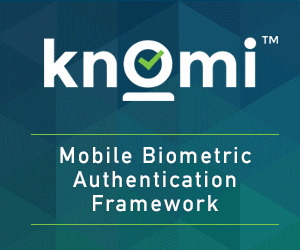There was a time – and it wasn’t so long ago – when biometric authentication was an extremely niche area of technological research and security. Indeed, until recently, the idea of scanning a fingerprint or face or eye for identification was often placed in the realm of science fiction, so far as pop culture has been concerned. But major historical events have helped to change that over the last couple of decades, with the 9/11 attacks ushering in a new era of biometric security, and the emergence of the smartphone helping to familiarize everyday consumers with the idea of biometric authentication.
The latter trend is also starting to usher in a greater understanding about another technological issue that is little understood at present, just as biometrics used to be – the idea of on-device data storage and processing. Most everyday consumers aren’t familiar with this concept, but attitudes are shifting as the spectre of biometric spoofing grows along with the prevalence of biometric authentication systems.
The Primer

This critical turning point is where we kicked off On-Device Biometrics Month, with a Primer assessing exactly how consumer-focused tech companies like Apple have helped to popularize the on-device approach to biometric authentication. The Primer also offered a brief overview of the FIDO Alliance – the authentication industry’s most important standards and advocacy group – and looked at new and emerging areas where the on-device approach is helping to make a big difference in data security. For anyone still coming to grips with the whole issue of on-device security, this is a great place to start.
The Rise of FIDO

While the Primer was intended as a helpful overview of the topic of on-device biometrics, the fact is that FIDO merits more than just the glancing mention it received there. It’s an extremely important industry alliance comprising some of the biggest names in tech today, so naturally our next feature, “The Rise of FIDO“, offered a closer look at the organization, outlining its history, surveying its growing ecosystem of certified solutions and its evolving body of standards, and assessing its influential advocacy work for post-password security. To a considerable extent, understanding on-device biometrics means understanding the FIDO Alliance and what it does, so in its own way, this feature is an important kind of primer, too.
The Next Wave in Payments

Our third feature for On-Device Biometrics Month also returned to a topic mentioned only briefly in the Primer – the emergence of biometric payment cards. It might sound a bit niche, but in fact this is one of the best illustrations of the importance of the on-device approach to authentication security. Pretty soon, fingerprint-scanning payment cards are going to be in the hands of millions of consumers, applying biometric authentication to countless transactions every day. It would seem to be a ripe opportunity for fraudsters and hackers, but major stakeholders in the financial services sector, including Mastercard, Visa, and major banks, have been looking at on-device solutions for biometric enrollment and authentication to neutralize the threat of hack attacks and related kinds of fraud from the outset.
Highly Aware Expert Commentary

For the final week of On-Device Biometrics Month, we switched media and got more conversational, bringing Aware, Inc. VP David Benini onto the FindBiometrics and Mobile ID World podcast. Aware is one of the premier providers of FIDO-certified, on-device security technology, through its Knomi mobile authentication SDK, so Benini proved to be a highly knowledgeable expert in discussing the topic with FindBiometrics Managing Editor Peter Counter. The two kicked things off with a discussion of FIDO and authentication standards, and moved onto enterprise considerations, the importance liveness detection, and what’s in the pipeline for the authentication industry in the years to come.
*
On-Device Biometrics Month is made possible by our sponsor, Aware, Inc.
May 30, 2019 – by Alex Perala








Follow Us